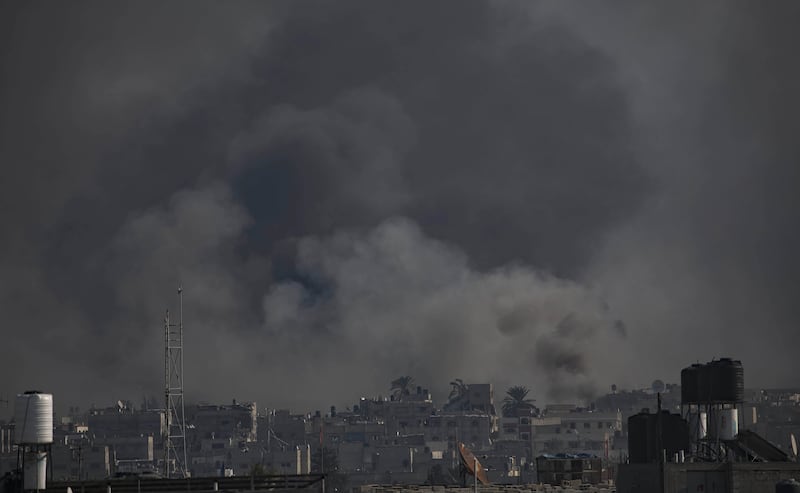The US military on Tuesday carried out a new strike in Yemen against four Houthi anti-ship ballistic missiles, two US officials said – the latest move against the Iran-aligned group over its targeting of Red Sea shipping.
One of the officials said the missiles were struck because they were being prepared to target ships in the region. The US strikes came a day after Houthi forces hit the US-owned and operated dry bulk ship Gibraltar Eagle with an anti-ship ballistic missile.
Houthi attacks on Red Sea shipping have continued even after the US and Britain last week launched an initial wave of strikes to degrade Houthi capabilities.
The Houthis, who control the most populous parts of Yemen, have claimed their attacks on commercial ships are aimed at supporting the Palestinians in Israel’s war in Gaza. Their attacks have disrupted global shipping and stoked fears of global inflation. They have also deepened concern that fallout from the Israel-Hamas war could further destabilise the Middle East.
The great tragedy is there’s no political pendulum to restrain Israel’s Cromwellian impulses
Humanity might yet prove the species that was too stupid and greedy to save itself
Hamas accused of attack on bus that killed eight Gaza food aid workers
Israeli strike on Iran is unlikely without green light from Trump
The Houthi movement has said it will keep up attacks despite the strikes last week against radar and missile capabilities. Some experts believe they welcome a conflict with the US and its allies.
[ The Irish Times view on the conflict in the Red Sea: a real test for EU diplomacyOpens in new window ]
A Malta-flagged, Greek-owned bulk carrier was targeted and hit by a missile while northbound in the Red Sea, 76 nautical miles northwest of the Yemeni port of Saleef, a security firm said on Tuesday.
On Monday, the Gibraltar Eagle’s US-based operator Eagle Bulk Shipping said it was hit by an “unidentified projectile” while travelling 160km off the Gulf of Aden. The attack caused a fire in a hold of the vessel but no injuries, and the ship was continuing on its way, it said.
Container vessels have been pausing or diverting from the Red Sea, leading to the Suez Canal – the fastest freight route from Asia to Europe. Many ships have been forced to take the longer route via the Cape of Good Hope instead.

Meanwhile, Israeli tanks stormed back into parts of the northern Gaza Strip they had left last week, residents said on Tuesday, reigniting some of the most intense fighting since the new year when Israel announced it was scaling back its operations there.
Massive explosions could be seen over northern areas of Gaza from across the border with Israel – a rarity over the past two weeks after Israel announced a drawdown of forces in the north as part of a transition to smaller, targeted operations.
The rattle of gunfire reverberated across the border through the night. In the morning, contrails snaked through the sky as Israel’s Iron Dome defences shot down rockets fired by militants across the fence, demonstrating that they retain the capability to launch them despite more than 100 days of war.
Israel said its forces had killed dozens of Hamas fighters overnight in clashes in Beit Lahiya on Gaza’s northern edge. Gaza health authorities said the last 24 hours of Israeli bombing had killed 158 people in the Palestinian enclave, raising their toll for the war, now in its fourth month, to 24,285, with thousands more bodies feared lost in the rubble.
[ Rishi Sunak dodges question of UK’s Middle East strategy after Yemen air strikesOpens in new window ]
Israel launched its war to eradicate Hamas after militants stormed across the border fence on October 7th, killing 1,200 people and capturing 240 hostages, according to Israeli tallies.
The war has driven nearly all Gazans from their homes, some of them several times, and caused a humanitarian crisis, with food, fuel and medical supplies running low.
Under US pressure to reduce civilian casualties, Israel had said it was moving from a full-scale ground assault to targeted operations against the Hamas militants that control the enclave.
It began that shift with a pullback in the north. Defence minister Yoav Gallant also said on Monday that the more recent ground assault in the south was drawing to a close.
Any path toward de-escalating the war still seems remote, with Israel saying it will not rest until Hamas is destroyed, and the militants showing no sign of losing the ability to resist.
[ What is the risk of the conflict in Gaza escalating?Opens in new window ]
Israel Ziv, a retired general who formerly commanded Israeli forces in Gaza, told Reuters that 10-15 per cent of Hamas’s pre-war rocketry corps of some 1,000 personnel were believed to be still alive, with some 2,000 rockets still left to be fired.
However, Mr Ziv said, Israeli forces had by now established “extensive control” in Gaza, meaning they could “manoeuvre freely”, except in Rafah, Deir al-Balah and Nusseirat, the launch point of Tuesday’s rocket salvo.
In the Gaza City suburb of Al-Nafaq in the north, rescuers recovered 20 bodies from a residential building hit by Israel overnight, the Gaza Civil Emergency Service said.
Israeli forces have fought their way to the centre of Gaza’s main southern city of Khan Younis, and into towns north and east of the central city of Deir al-Balah.
Most of Gaza’s 2.3 million people are now crowded into a few areas where Israeli forces have largely not entered, including Deir al-Balah and Rafah, located on the southern edge of the Strip, bordering Egypt.
Meanwhile, two bases of Baluchi militant group Jaish al Adl in Pakistan were targeted by missiles on Tuesday, Iranian state media reported, a day after Iran’s elite Revolutionary Guards attacked targets in Iraq and Syria with missiles.
The militant group has previously mounted attacks on Iranian security forces in the border area with Pakistan. – Reuters












